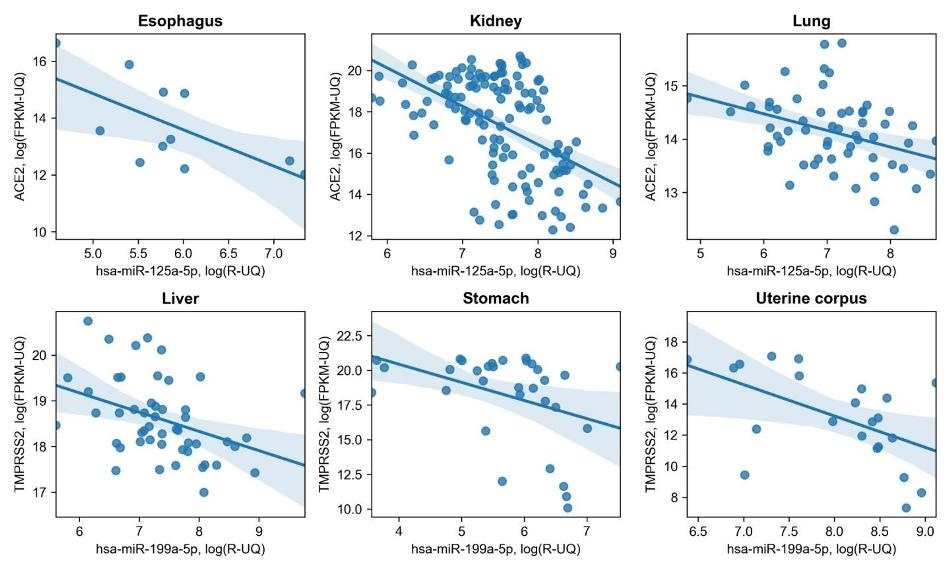A research team from the National Research University Higher School of Economics (HSE University) has designed innovative methods for controlling the expression of TMPRSS2 and ACE2 enzymes.

Joint distribution of significant hsa-miR-125a-5p / ACE2 and hsa-miR-199-5p / TMPRSS2 interactions in different organs. Light blue regions correspond to 95% confidence intervals. Image Credit: Nersisyan, et al.
These enzymes play a major role in cells infected with SARS-CoV-2. The researchers found that small non-coding microRNA, or miRNA, molecules can cause a targeted reduction of TMPRSS2 and ACE2 enzymes. The study results were published in the PLOS ONE journal.
The enzymes—transmembrane serine protease 2 (TMPRSS2) and angiotensin-converting enzyme 2 (ACE2)—serve as access gates into the cell for the novel SARS-CoV-2. Once the virus successfully penetrates the cells, it uses the recourses of cells to duplicate and leave this cell to infect new types of cells. Globally, researchers are testing the medicinal effect on TMPRSS2 and ACE2 enzymes in an effort to block the SARS-CoV-2 virus from penetrating the human cells.
Furthermore, the ACE2 enzyme contributes significantly to the development of acute respiratory distress syndrome, the leading cause of death in patients affected by COVID-19. Besides the respiratory organs, TMPRSS2 and ACE2 also exist in different parts of the body, including the liver, kidneys, and digestive system. This elucidates the range of symptoms, such as gastrointestinal problems, that manifest in patients.
Stepan Nersisyan and Alexander Tonevitsky, from the Faculty of Biology and Biotechnology at HSE University, along with their collaborators Maxim Shkurnikov from Hertsen Moscow Oncology Research Center, Evgeny Knyazev from Shemyakin-Ovchinnikov Institute of Bioorganic Chemistry RAS, and Andrey Turchinovich from German Cancer Research Center, Heidelberg, examined the potential methods for regulating the aforementioned enzymes through miRNA molecules.
The researchers performed bioinformatic analysis of openly accessible datasets on RNA sequencing in tissues of 10 major human organs. The key task was to identify miRNAs whose expression would show a considerable negative correlation with the gene expression of TMPRSS2 and ACE2.
This implies that miRNA is inversely proportional to TMPRSS2 and ACE2, and vice versa. Consequently, the scientists detected a specific amount of these communications that are specific to many organs simultaneously.
Particularly, the researchers found that lysine-specific demethylase 5B (JARID1B) can indirectly have an impact on the expression of ACE2/TMPRSS2 by repressing the transcription of hsa-mir-141/hsa-miR-200 and hsa-let-7e/hsa-mir-125a miRNA families that target such genes.
Source:
Journal reference:
Nersisyan, S., et al. (2020) Integrative analysis of miRNA and mRNA sequencing data reveals potential regulatory mechanisms of ACE2 and TMPRSS2. PLOS ONE. doi.org/10.1371/journal.pone.0235987.